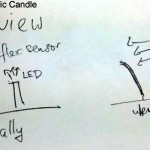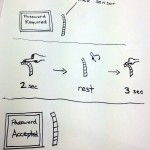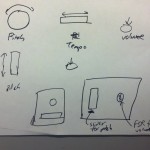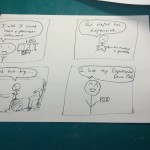Krithin Sitaram (krithin@)
Amy Zhou (amyzhou@)
Daniel Chyan (dchyan@)
Jonathan Neilan (jneilan@)
Thomas Truongchau (ttruongc@)
Group 11
Expressive Drum Pad
We built a drum pad that can play a range of pitches controlled by a softpot (touch sensitive slide), along with a range of amplitudes controlled by a FSR. The harder a performer strikes the FSR, the louder the buzzer sounds. Sliding towards the right will cause an increase in pitch, while sliding towards the left will cause a decrease in pitch. Combining the two controls, a performer can play a variety of virtuosic pieces that require a single voice. We decided to build the Expressive Drum Pad because we all appreciate music creation and wanted to contribute to the creative musical process. The Expressive Drum Pad turned out nicely as it allows the performer to control pitch and amplitude rather effectively through an intuitive, yet unpolished interface. Future improvements would include having an enclosure to hold down the sensors.
- Design 1: An Electronic Birthday Candle
- Design 2: A Biometric Flexor Password Device
- Design 3: The Expressive Drum Pad
- Storyboard for the Expressive Drum Pad
http://www.youtube.com/watch?v=VD8VC3npgwg
Parts Used
– 1 Arduino
– 1 FSR
– 1 softpot (touch-sensitive slide)
– Buzzer (replaced by computer speakers for additional volume)
[Reid approved this substitution.]
Connect the softpot to 5V, Ground, and an Arduino analog input pin. Connect the buzzer (computer speakers) in series with the FSR as part of the circuit from an Arduino digital output pin to ground. Angle the breadboard such that the softpot and FSR lie flat on a table.
Source Code:
int OUTPUTPIN = 3;
int FSRPIN = 5;
int SOFTPOTPIN = 0;
int MINSOFTPOT = 0;
int MAXSOFTPOT = 1024;
int MINPITCH = 120;
int MAXPITCH = 1500;
void setup() {
pinMode(OUTPUTPIN, OUTPUT);
Serial.begin(9600);
}
void loop() {
int frequency = map(analogRead(SOFTPOTPIN), MINSOFTPOT, MAXSOFTPOT, MINPITCH, MAXPITCH);
tone(OUTPUTPIN, frequency);
delay(2);
Serial.println(analogRead(FSRPIN));
}




